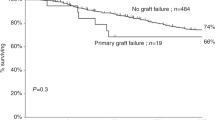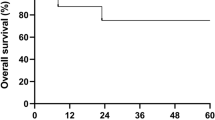Abstract
Bone marrow transplantation (BMT) from siblings is the treatment of choice for severe combined immunodeficiency (SCID). The objective of this study was to evaluate the efficiency of BMT from matched unrelated donors (MUD) in congenital immunodeficiencies when a sibling donor is unavailable. Sixteen consecutive patients with SCID (n = 9) and CID (n = 7), were referred for an unrelated donor search. Acceptable donors were found for all patients. Fifteen patients received busulfan and cyclophosphamide pretransplant conditioning. One patient had an early loss of graft and was reconditioned using cyclophosphamide and total body irradiation. The graft-versus-host disease (GVHD) prophylaxis used was methylprednisolone, cyclosporin A with or without methotrexate. Neutrophil engraftment was rapid and was achieved in all patients within a mean of 15.4 days. Only 13 episodes of fever were recorded shortly after BMT. GVHD of grade II or more was apparent in 2/9 (22%) of SCID patients and in 4/7 (57%) of CID patients. Overall survival was 75% with a mean follow-up of 47.4 months (range 18–101). Six out of nine SCID patients (67%) and 6/7 (86%) of CID patients are alive and well. Eleven patients had normal humoral immunity, and cell-mediated immunity as measured by flow cytometry and mitogenic responses, was intact in all patients. Intradermal candida skin test was positive in 9/10 patients tested. We conclude that BMT from MUD results in rapid engraftment and is therefore associated with a low rate of infection contributing to the improved survival rate. The protocol used is especially favorable for patients with combined immunodeficiency. Bone Marrow Transplantation (2000) 25, 613–621.
This is a preview of subscription content, access via your institution
Access options
Subscribe to this journal
Receive 12 print issues and online access
$259.00 per year
only $21.58 per issue
Buy this article
- Purchase on Springer Link
- Instant access to full article PDF
Prices may be subject to local taxes which are calculated during checkout

Similar content being viewed by others
References
Gatti RA, Meeuwissen HJ, Aller HD et al. Immunological reconstitution of sex-linked lymphopenic immunological deficiency Lancet 1968 2: 1366–1369
Bach FH, Albertini RJ, Anderson JL et al. Bone marrow transplantation in a patient with the Wiscott–Aldrich syndrome Lancet 1968 2: 1364–1366
Levinski RJ, Davies EG, Butler M, Abai A . Problems of mismatched bone marrow transplantation for severe combined immunodeficiency after soybean lectin fractionation Birth Def 1983 19: 147–150
O'Reilly RJ, Pollack MS, Kapoor N . Fetal liver transplantation in man and animals. In: Gale RP (ed) Recent Advances in Bone Marrow Transplantation Alan R Liss: New York 1983 pp 799–830
Touraine JL, Laplace S, Rezzoug F et al. The place of fetal liver transplantation in the treatment of inborn errors of metabolism J Inher Metab Dis 1991 14: 619–626
Haddad E, Landais P, Friedrich W et al. Long-term immune reconstitution and outcome after HLA-non-identical T cell-depleted bone marrow transplantation for severe combined immunodeficiency: a European retrospective study of 116 patients Blood 1998 19: 3646–3653
Bertrand Y, Landais P, Friedrich W et al. Influence of severe combined immunodeficiency phenotype on the outcome of HLA non-identical, T-cell-depleted bone marrow transplantation J Pediatr 1999 134: 740–748
Buckley RH, Schiff SE, Schiff RI et al. Hematopoietic stem-cell transplantation for the treatment of severe combined immunodeficiency New Engl J Med 1999 340: 508–516
Fischer A, Landais P, Friedrich W et al. European experience of bone marrow transplantation for severe combined immunodeficiency Lancet 1990 336: 850–854
O'Reilly RJ, Keever CA, Small TN et al. The use of HLA-non-identical T cell-depleted marrow transplants for correction of severe combined immunodeficiency disease Immunodef Rev 1989 1: 273–309
Buckley RH, Schiff SE, Sampson HA et al. Development of immunity in human severe primary T-cell deficiency following haploidentical bone marrow stem cell transplantation J Immunol 1986 136: 2398–2407
Dror Y, Gallagher R, Wara DW et al. Immune reconstitution in severe combined immunodeficiency disease after lectin-treated, T cell-depleted haplocompatible bone marrow transplantation Blood 1993 81: 2021–2030
Friedrich W, Goldmann SF, Ebell W et al. Severe combined immunodeficiency; treatment by bone marrow transplantation in 15 infants using HLA-haploidentical donors Eur J Pediatr 1985 144: 125–130
Rumelhart SL, Trigg ME, Horowitz SD et al. Monoclonal antibody T cell-depleted HLA-haploidentical bone marrow transplantation for Wiskott–Aldrich syndrome Blood 1990 75: 1031–1035
Fischer A, Friedrich W, Fasth A et al. Reduction of graft failure by a monoclonal antibody (anti-LFA-1 CD11a) after HLA nonidentical bone marrow transplantation in children with immunodeficiencies, osteopetrosis and Fanconi's anemia: a European group for immunodeficiency/European Group for Bone Marrow Transplantation report Blood 1991 77: 249–256
Arpaia E, Shahar M, Dadi H et al. Defective T cell receptor signaling and CD8+ thymic selection in humans lacking Zap-70 kinase Cell 1994 76: 947–958
Sharfe N, Dadi HK, Shahar M et al. Human immune disorder arising from mutation of the α chain of the interleukin-2 receptor Proc Natl Acad Sci USA 1997 94: 3168–3171
Alarcon B, Regueiro JR, Arnaiz-Villena A et al. Familial defect in the surface of expression of the T-cell receptor CD3 complex New Engl J Med 1988 319: 1203–1208
Sharfe N, Shahar M, Roifman CM . An interleukin-2 receptor γ chain mutation with normal thymus morphology J Clin Invest 1997 100: 3036–3043
Hirschhorn R . Overview of biochemical abnormalities and molecular genetics of adenosine deaminase deficiency Pediatr Res 1993 3: (Suppl. ) S35–S41
Fischer A, Griscelli C, Friedrich W et al. Bone marrow transplantation for immunodeficiencies and osteopetrosis: European survey: 1968–1985 Lancet 1986 2: 1080–1083
Petersdorf EW, Longton GM, Anasetti G et al. The significance of HLA-DRB1 matching on clinical outcome after HLA-A, B, DR, identical unrelated donor marrow transplantation Blood 1995 86: 1606–1613
Hansen JA, Clift RA, Thomas ED et al. Histocompatibility and marrow transplantation Transplant Proc 1979 11: 1924–1929
Storb R, Deeg HJ, Whitehead J et al. Methotrexate and cyclosporin compared with cyclosporin alone for prophylaxis of acute graft-versus-host disease after marrow transplantation for leukemia New Engl J Med 1986 314: 729–735
Primary immunodeficiency diseases . Report of a WHO scientific group Clin Exp Immunol 1995 99: 1–24
Melamed A, Cohen A, Roifman CM . Expansion of CD3+ CD4− CD8− T cell subpopulation expressing high levels of IL-5 in Omenn's syndrome Clin Exp Immunol 1994 95: 14–21
Filipovich AH, Shapiro RS, Ramsay NKC et al. Unrelated donor bone marrow transplantation for correction of lethal congenital immunodeficiencies Blood 1992 80: 270–276
Kernan NA, Bartsch G, Ash RC et al. Analysis of 462 transplantation from unrelated donors facilitated by the national marrow donor program New Engl J Med 1993 328: 593–602
Fischer A, Durandy A, de Villartay JP et al. HLA-haploidentical bone marrow transplantation for severe combined immundeficiency using E rosette fractionation and cyclosporin Blood 1986 67: 444–449
Buckley RH, Schiff SE, Schiff RI et al. Haploidentical bone marrow transplantation in human severe combined immunodeficiency Semin Hematol 1993 30: (Suppl. 4) 92–104
Van Leeuwen JEM, van Tol MJF, Joosten AM et al. Relationship between patterns of engraftment in peripheral blood and immune reconstitution after allogeneic bone marrow transplantation for (severe) combined immunodeficiency Blood 1994 94: 3936–3947
Wijnaendts L, LeDeist F, Griscelli C et al. Development of immunologic functions after bone marrow transplantation in 33 patients with severe combined immunodeficiency Blood 1989 74: 2212–2219
Hayward AR, Murphy S, Githens J et al. Failure of a pan-reactive anti-T cell antibody, OKT3, to prevent graft-versus-host disease in severe combined immunodeficiency J Pediatr 1982 100: 665–668
Morgan G, Linen DC, Knott LT et al. Successsful haploidentical mismatched bone marrow transplantation in severe combined immunodeficiency: T cell removal using CAMPATH-1 monoclonal antibody and E-rosetting Br J Haematol 1986 62: 421–430
Fischer A, Landais W, Friedrich W et al. Bone marrow transplantation (BMT) in Europe for primary immunodeficiencies other than severe combined immunodeficiency: a report from the European Group for BMT and the European Group for Immunodeficiency Blood 1994 83: 1149–1154
Acknowledgements
We would like to thank Drs Fred Rosen and Trudy Small for their valuable comments, and also Penny Sotiropoulos and Brenda Lynch for their assistance with manuscript preparation. This work has been supported by the Donald and Audrey Campbell Chair in Immunology (CMR) and the Medical Research Council of Canada (CMR).
Author information
Authors and Affiliations
Rights and permissions
About this article
Cite this article
Dalal, I., Reid, B., Doyle, J. et al. Matched unrelated bone marrow transplantation for combined immunodeficiency. Bone Marrow Transplant 25, 613–621 (2000). https://doi.org/10.1038/sj.bmt.1702215
Received:
Accepted:
Published:
Issue Date:
DOI: https://doi.org/10.1038/sj.bmt.1702215
Keywords
This article is cited by
-
Hematopoietic Stem Cell Transplantation for Children With Inborn Errors of Immunity
Indian Pediatrics (2021)
-
Allogeneic hematopoietic stem cell transplantation in two brothers with DNA ligase IV deficiency: a case report and review of the literature
BMC Pediatrics (2019)
-
Long-Term Outcomes of Hematopoietic Stem Cell Transplantation for ZAP70 Deficiency
Journal of Clinical Immunology (2016)
-
Hematopoietic Stem Cell Transplantation for Severe Combined Immunodeficiency
Current Pediatrics Reports (2015)
-
Global overview of primary immunodeficiencies: a report from Jeffrey Modell Centers worldwide focused on diagnosis, treatment, and discovery
Immunologic Research (2014)



